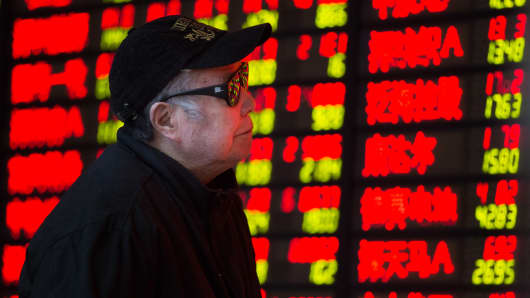Over the past decade, rallies of this magnitude in A-shares have led to a correction at some point. In fact, corrections should be seen as "normal" in a market that experiences such high volatility. However, even if A-shares do pull back this time, the correction is unlikely to prevent MSCI EM Asia from outperforming other developing world equities over at least the next six months.
A-shares do not form part of MSCI China or MSCI EM Asia. The only mainland stocks included in MSCI China are B-shares. These are denominated in Hong Kong dollars or U.S. dollars rather than Chinese yuan and make up just 1 to 2 percent of MSCI China, which in turn is 35 to 40 percent of MSCI EM Asia.
Although some stocks are listed in both Hong Kong and mainland China, the correlation between the two markets is inconsistent. The two biggest rallies in A-shares in the past decade provide good examples.
Read MoreChina see-saw ride? Don't sweat it.
The first rally ended in October 2007, at the onset of the global financial crisis. From peak to trough, A-shares delivered total losses of 67 percent in U.S. dollars, compared with a 73 percent peak-to-trough decline for MSCI China. The second rally ran out of steam in December 2009, after lasting more than a year. From peak to trough, A-shares lost 29 percent. However, MSCI China experienced only a limited contagion, with losses of 10 percent over the same period. Four months later, both A-shares and MSCI China had rallied to new post-crisis peaks in U.S. dollar total return terms.
Any A-share correction this time around is also likely to have a much more limited contagion effect on MSCI China, for a number of reasons. First, institutional investors own 60 to 70 percent of MSCI China, including H-shares, while mainland Chinese retail investors, who tend to behave in a more volatile manner than institutions, own roughly 80 percent of the A-share market.
Second, the A-share market is trading only slightly above its 10-year average as a multiple of corporate earnings. MSCI China is priced below its 10-year average, at 12.5 times trailing earnings. Third, A-shares of companies with dual A- and H-share listings are valued at a 25 percent premium to their H-shares, providing a cushion for H-share investors.
We also expect China's ongoing monetary easing to support interest-rate-sensitive sectors, including banks, insurance and property. We expect another interest rate cut and two more reserve requirement ratio cuts to support money growth before the end of 2015. The recent landmark local government bond sale is a sign of reform progress favorable to the financial sector. The pickup in property sales in April was also encouraging and provides some cushion to the property sector.
Read MoreChina stocks nearly a quarter overvalued: Credit Suisse
Given all these factors, we maintain a tactical preference for Asian emerging markets, as defined by MSCI EM Asia, over developing world equities overall. Over the next six months, they will continue to benefit from stronger earnings growth and lower valuations relative to their history than their peers as well as subdued commodity prices and the ongoing U.S. recovery. They are also more resilient to higher global interest rates than their counterparts in Latin America, or in emerging Europe, the Middle East and Africa (EMEA). On a six-month view, we do not expect the volatility in Chinese equities to derail the more favorable outlook for the MSCI EM Asia index.
Jorge Mariscal is the emerging markets chief investment officer at UBS Wealth Management.


